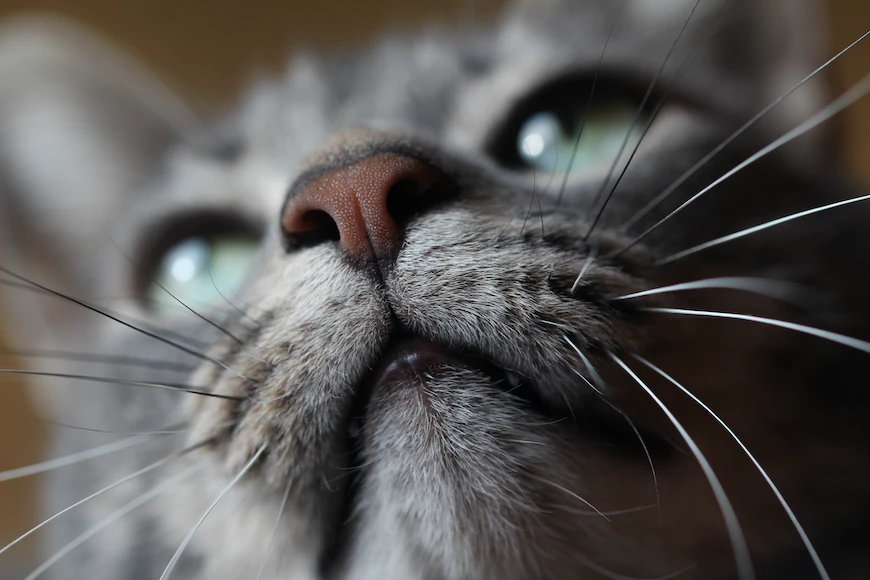
Long-haired cats are especially likely to have very long whiskers and eyebrows, but they are never too long for the cat.
Avoid trimming your cat’s whiskers or eyebrows. They play a role in several important sensory functions, including depth perception, proprioception, and even night vision. Lost or cut whiskers will grow back but the animal might experience a temporary loss of agility, which is a major problem, especially for cats that go outdoors.
Whiskers and eyebrows are essential and complex sensory tools for felines, and we are just beginning to understand their full function.
What Do Whiskers and Eyebrows Do for Cats?
The University of Melbourne’s Veterinary Hospital conducted a study dedicated to the function of vibrissae, or whiskers. Whiskers were found to be the animal’s navigation tools, and sensory organs helping the cat’s awareness of self relatively to other objects.
A cat’s vibrissae are sophisticated sensory tools. Each one of them has an individual role for the animal. Amazingly, every single eyebrow and whisker has a sensory receptor at the end of it with a corresponding area in the brain that receives the signals from that particular vibrissa.
Each cheek has 12 whiskers. In addition to whiskers and eyebrows, there are finer and shorter vibrissae on the paws and the chin. The animal needs all of them – long or short – but occasional shedding of a whisker or two is normal.
Many hairless cats have few or no whiskers, but Sphynxes and other bald breeds have adapted to living without vibrissae.
Five Important Functions of Whiskers and Eyebrows
1. Proprioceptors
Thanks to the whiskers and eyebrows, cats sense the vibration from their movement or the movement of objects nearby.
The vibration tells the animals where they are about their surroundings. That is one of the mechanisms that helps cats maintain grace and accuracy and enables them to survive in a world where even a slight delay in reaction could be precarious.
As an example, felines can jump a long distance onto a very small surface and maintain balance, sometimes without even seeing where they are about to end up. A cat performs such moves regularly, with skill and grace only typical for cats. Vibrissae have a part in this ability.
2. Depth Perception
Whiskers enable the animals to gauge the depth and size of small spaces.
This skill is crucial to survival outside because cats often have to hide from either predators or the cold. They estimate and evaluate a tight space using the whiskers as radars and fingers. The cat does not feel the surface with the whiskers but senses the vibration from the movement of the air between its own body and the objects nearby.
3. Help with Balance
Although whiskers do not have a direct role in balance, their other functions could affect the ability to balance and navigate the surroundings in a complex situation.
The cat’s ability to balance is primarily regulated by its inner ear but having impaired depth perception or own muscle sensation has an impact on balancing, particularly when precision and quick reaction are important.
For indoor cats who are shielded from the dangers of the great outdoors, the loss of a couple or even several whiskers could lead to mild, if any, impairment, until the whiskers grow back. For pets who go outside or, moreover, feral cats, the loss of whiskers could spell trouble.
4. Night and Near Vision
The whiskers are especially important at night.
Cats see much better than us in the dark, but their eyes do not perceive depth all that well at night. Whiskers contribute to their awareness of the surroundings in the dark because cats detect the airflow.
Felines also do not have the greatest vision to discern the details of the objects right in front of them. Their vibrissae are helpful in that realm too.
5. Communication
Cats communicate their disposition with their vibrissae, among other body language ways.
The whiskers look relaxed when the cat is calm and sleepy. Any arousal causes the animal’s whiskers to face forward to communicate a range of states, from playfulness to defensiveness. A cat may express fear by having the whiskers pinned back against its head.
Is It Okay to Touch Whiskers and Eyebrows?
It is best to avoid touching cats’ whiskers and eyebrows. The cat may not like excessive stimulation associated with having their vibrissae touched. However, touching objects with the whiskers while exploring them does not overwhelm cats.
What If My Cat’s Whiskers and Eyebrows Are Too Long?
Your cat’s whiskers are not too long, even if they look very long.
There was a study published in the Journal of Feline Medicine and Surgery to evaluate whisker stress in cats. The study explores whether eating food out of the regular bowl, which causes daily stimulation of the whiskers, is a stressor for felines. Cats did not show a preference for whisker-friendly food and water bowls and seemed to be just as comfortable eating out of regular bowls.
Pets with longer vibrissae are at higher risk of losing them accidentally just because the whiskers tend to get into all the same things the cat gets into. If an animal gets too close to a working stove, a whisker or an eyebrow could get burned on accident, for example. Other than that, there is no difference between having longer or shorter whiskers and eyebrows.
Do Cats Feel Pain If a Whisker Is Cut or Damaged?
Dr. Richards, head of general practice at the University of Melbourne’s Veterinary Hospital, shares that cats do not feel any pain when a vibrissa is cut or damaged another way. The reason for that is the absence of any nerve endings in whiskers or eyebrows.
Disorientation, sensory change, and resulting anxiety are the concerns in the event of damage to the whiskers.
What If My Cat Lost A Few Whiskers?
Cats shed vibrissae just like they shed regular hair, and it is a normal process. They do not typically shed more than one or two at a time, so the animal does not feel any deficits while a new vibrissa is growing to replace the old one.
If a cat loses a few whiskers or eyebrows at one time, the animal will probably notice the difference in his or her senses, until the vibrissae grow back. It might not be a big deal for an indoor cat, but an outdoor cat might temporarily feel less confident surviving in nature.
Related Questions:
How Long Will It Take for Whiskers to Grow Back?
If your cat lost a few whiskers, it could take anywhere from a few weeks to three months for the whiskers to grow back entirely. Even when the whisker looks like it is back to its normal length, it could take a few more weeks for its full function to be restored.
Should I Trim a Burned Whisker?
Avoid trimming whiskers even if your cat accidentally burned one or several of them. The whisker will grow back. The burned part may fall off or the entire whisker may fall out, but it is just a matter of weeks or months for the cat to grow new whiskers or regrow the burned ones. Trimming a damaged whisker will not speed up recovery.
Recent Posts
Clown Killifish Clown Killifish (Epiplatys annulatus) are great fish for beginners, as well as people who want to avoid having a lot of equipment for their aquariums. They do well in community...
Border collies, and other herders, such as Shelties, Aussies, and corgis, are bright and energetic family pets. It is wise to consider if your household is the right fit for these dogs. You may...

